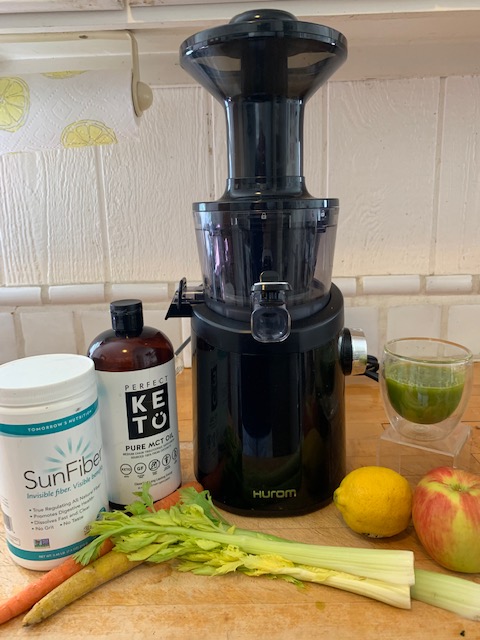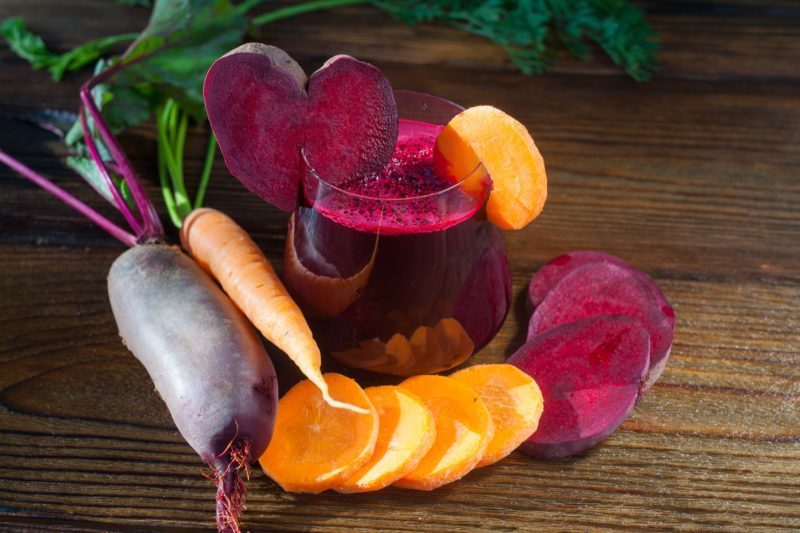That risk factor is called insulin resistance and it’s one of the root causes of diabetes, pre-diabetes, metabolic syndrome, obesity, heart disease and even Alzheimer’s (which is now sometimes referred to as Type lll Diabetes).
And since insulin resistance is—most often—a condition brought on by or aggravated by too many carbohydrates, a lower carb diet is, in my opinion, generally the best way to combat or prevent both insulin resistance and its almost certain outcome down the road, cardiometabolic disease.
So how can juicing fit into that worldview? After all, the big rap against juice is that it’s all just too much sugar!
Well…not so fast.
It’s true that commercial juices are frequently filled with added sugars, and even when they’re not, the natural sugars in the fruits and vegetables from which they are made can be too much for the average person. So most health gurus advocate eating the whole fruit and vegetable, not juicing them.
I have a somewhat different view.
I think that the biggest problem in our diets is processed food, high starch and high sugar. I also believe that people vary in their tolerance for carbohydrates, and vary in their ability to process them. Not everyone in the world needs to be on a very low-carb diet (though many people absolutely do), but reducing sugar and starch seems to me to be a good strategy across the board for everyone.
But fruits and vegetables are carbs, and they’re among the most nutrient dense foods on the planet. And while juicing does remove the fiber from these miraculous plants, the marvelous array of vitamins, minerals, phytochemicals, catechins and flavonoids remain.
Every eating decision is a trade-off. In this case the question is: Is the awesome array of nutrients I get from freshly made juice worth the amount of sugar that comes with it?
For me, the answer is yes and I’ll explain why in a minute. But I understand that for some people, even the natural sugar found in a glass of freshly made juice is going to be too much for their system to handle. If you’re one of the many people for whom that is true, you should probably stop reading now because this article doesn’t apply to you.
But if you’re not that person, and you can handle the natural sugar found in fruits and vegetables… then let me tell you about my juicing habit.
Full disclosure: I am, as you have probably figured out, a huge fan of juicing. My Hurom juicer—about more in a moment—is a big part of my daily life, and if it weren’t so big, I’d probably take it with me on vacation!
And I have a couple of hacks that make the sugar “hit” even softer.
 Remember, one of the big advantages of eating the whole fruit/vegetable is fiber. Fiber slows down the entrance of sugar into the bloodstream so your body secretes less insulin (that’s a good thing). Fiber also feeds the good bacteria in the microbiome, which is related to, well, everything. So here’s my hack: I simply add a heaping scoop of SunFiber to my juice. It’s odorless, tasteless and gives you no digestive upset.
Remember, one of the big advantages of eating the whole fruit/vegetable is fiber. Fiber slows down the entrance of sugar into the bloodstream so your body secretes less insulin (that’s a good thing). Fiber also feeds the good bacteria in the microbiome, which is related to, well, everything. So here’s my hack: I simply add a heaping scoop of SunFiber to my juice. It’s odorless, tasteless and gives you no digestive upset. The second thing I add to my juice is fat, for two reasons. One: Many of the nutrients in juice—like the carotenoids in carrots—are fat-soluble and won’t be absorbed as effectively without fat. Two: Fat, like fiber, slows down the “glycemic response” (blood sugar reaction). So by adding healthy fat to the mix, you’re gaining nutrients and diminishing the blood sugar effect. Boom!
(My fat of choice is MCT-oil. I generally alternate between Bulletproof’s Brain Octane Oil and Perfect Keto’s Pure MCT Oil.)
For the juice itself I have two basic recipes, both very improvisational.
For the red one, I use one or two red peppers, two or three beets, a few apples and dark (purple) carrots. For the green one, I use one or two green peppers, a couple of golden beets, a cucumber, some spinach, and the lighter (white or orange) carrots. For both juices I add a significant amount of fresh ginger, fresh turmeric and at least half a lemon including the peel.
I’ve used the Hurom slow juicer for years. It’s my favorite juicer by far. (I have no financial interest in Hurom, though I wish I did!) I like “slow” juicing because it works at lower heat and retains far more of the nutrients in the plants and produces a juice that is consistently delicious.
So we’ve addressed the “sugar problem”, now let’s address the single biggest objection to juicing that I hear from my tribe: “It takes too much time!”
Here’s my answer to that: You’re right. It does take time. Based on my experience—and I’m pretty efficient at this point—it’s a good 20 minutes from start to clean-up and that’s if you’re fast.
To which I say: So what? When I started juicing, I had the same objection. It takes forever and clean-up is a nightmare. (I also had time concerns with the practice of meditating, which I started two years ago and now don’t know how I lived without.) The point is, you find the time to do it. In my case, that 20 or so minutes is almost like a meditative ritual. I’ve made it part of my own self-care program, and I don’t resent a minute of it. And I have a really busy life. If I can make that change in how I think about the time things take, so can you.
As far as clean-up goes, the newer models of the Hurom are light-years ahead of the competition. The worst part about cleaning a juicer is getting all the fibrous stuff left behind out of the hidden corners and crevices of the juicer. But Hurom now has a little snap-off guard that exposes all of the stuff you used to have to dig for. You snap it off, rinse everything under the sink, and clean-up time (and effort) is significantly reduced.
Here’s how I look at it: I invest 20 minutes every two days (i.e. 10 min a day). For that I get at least a quart of the most nutritious plant juice on the planet that I use to hydrate myself with for the next 48 hours.
If that’s not a health bargain, I don’t know what is.
Note: The views and opinions expressed here are those of the author(s) and contributor(s) and do not necessarily reflect those of the publisher and editors of WholeFoods Magazine.










